Influence of Geocomposite Properties on the Crack Propagation and Interlayer Bonding of Asphalt Pavements
Abstract
:1. Introduction
2. Laboratory Investigation
2.1. Materials
2.2. Laboratory Specimens Preparation
2.3. Leutner Shear Test
2.4. Three-Point Bending Test
2.5. Reflective Cracking Test
3. Field Investigation
3.1. Trial Section Description
3.2. FWD Campaign
4. Results and Analysis
4.1. Leutner Test Results
4.2. Three-Point Bending Test Results
4.2.1. Performance Coefficient k
4.2.2. J-Integral
4.3. Reflective Cracking Test Results
- First stage: the specimen is intact. The final point of the first stage is indicated as a black triangle on the curves in Figure 12.
- Second stage: a crack originates from the notch and quickly reaches the geocomposite. From now on, the geocomposite plays a major role in delaying the crack propagation in the upper layer. This second phase is almost linear and the slope represents the crack propagation rate. The final point of the second stage, indicated as a black square on the curves in Figure 12, was considered as the specimen failure, at which the number of cycles to failure Nf RC was computed. The initial and final points of the second stage were identified thanks also to the analysis of the recording made during the tests, as shown in Figure 13 (where the front surface of the specimen is painted in white, the interface is marked in red and the cracks are highlighted in green). The crack propagation rate and the Nf RC values obtained for all reinforced systems are summarized in Table 2.
- Third stage: the crack is clearly evident on the upper surface of the specimen and high deflections are registered.
4.4. FWD Test Results
5. Conclusions
Author Contributions
Funding
Institutional Review Board Statement
Informed Consent Statement
Data Availability Statement
Acknowledgments
Conflicts of Interest
References
- Zornberg, J.G. Functions and applications of geosynthetics in roadways. Procedia Eng. 2017, 189, 298–306. [Google Scholar] [CrossRef]
- Zofka, A.; Maliszewski, M.; Maliszewska, D. Glass and carbon geogrid reinforcement of asphalt mixtures. Road Mater. Pavement Des. 2016, 18 (Suppl. 1), 471–490. [Google Scholar] [CrossRef]
- Vismara, S.; Molenaar, A.A.A.; Crispino, M.; Poot, M.R. Towards a better understanding of the benefits of geosynthetics embedded in asphalt pavements. In Proceedings of the TRB Annual Meeting, Washington, DC, USA, 22–26 January 2012. [Google Scholar]
- Zheng, C.C.; Najd, A. Effects of glass fiber/grid reinforcement on the crack growth rate of an asphalt mix. In 7th RILEM International Conference on Cracking in Pavements; Scarpas, A., Kringos, N., Al-Qadi, I., Eds.; Springer: Dordrecht, The Netherlands, 2012; pp. 1145–1155. [Google Scholar] [CrossRef]
- Norambuena-Contreras, J.; Gonzalez-Torre, I. Influence of geosynthetic type on retarding cracking in asphalt pavements. Constr. Build. Mater. 2015, 78, 421–429. [Google Scholar] [CrossRef]
- Saride, S.; Kumar, V.V. Influence of geosynthetic-interlayers on the performance of asphalt overlays on pre-cracked pavements. Geotext. Geomembr. 2017, 45, 184–196. [Google Scholar] [CrossRef]
- Vismara, S.; Molenaar, A.A.A.; Crispino, M.; Poot, M.R. Characterizing the effects of geosynthetics in asphalt pavements. In 7th RILEM International Conference on Cracking in Pavements; Scarpas, A., Kringos, N., Al-Qadi, I., Eds.; Springer: Dordrecht, The Netherlands, 2012; pp. 1199–1207. [Google Scholar] [CrossRef]
- Kumar, V.V.; Saride, S. Evaluation of cracking resistance potential of geosynthetic reinforced asphalt overlays using direct tensile strength test. Constr. Build. Mater. 2018, 162, 37–47. [Google Scholar] [CrossRef]
- Correia, N.S.; Zornberg, J.G. Mechanical response of flexible pavements enhanced with geogrid-reinforced asphalt overlays. Geosynth. Int. 2015, 23, 183–193. [Google Scholar] [CrossRef] [Green Version]
- Correia, N.S.; Zornberg, J.G. Strain distribution along geogrid-reinforced asphalt overlays under traffic loading. Geotext. Geomembr. 2018, 46, 111–120. [Google Scholar] [CrossRef]
- Lee, J.-H.; Baek, S.-B.; Lee, K.-H.; Kim, J.-S.; Jeong, J.-H. Long-term performance of fiber-grid-reinforced asphalt overlay pavements: A case study of Korean national highways. J. Traffic Transp. Eng. 2019, 6, 366–382. [Google Scholar] [CrossRef]
- Wang, H.; Guo, Y.; Wu, M.; Xiang, K.; Sun, S. Review on structural damage rehabilitation and performance assessment of asphalt pavements. Rev. Adv. Mater. Sci. 2021, 60, 438–449. [Google Scholar] [CrossRef]
- Graziani, A.; Pasquini, E.; Ferrotti, G.; Virgili, A.; Canestrari, F. Structural response of grid-reinforced bituminous pavements. Mater. Struct. 2014, 47, 1391–1408. [Google Scholar] [CrossRef]
- Ferrotti, G.; Canestrari, F.; Virgili, A.; Grilli, A. A strategic laboratory approach for the performance investigation of geogrids in flexible pavements. Constr. Build. Mater. 2011, 25, 2343–2348. [Google Scholar] [CrossRef]
- Canestrari, F.; Grilli, A.; Santagata, F.A.; Virgili, A. Interlayer Shear Effects of Grid Reinforcements. In Proceedings of the 10th International Conference on Asphalt Pavements, Quebec City, QC, Canada, 12–17 August 2006; Volume 1, pp. 811–820. [Google Scholar]
- Sudarsanan, N.; Karpurapu, R.; Amrithalingam, V. An investigation on the interface bond strength of geosynthetic-reinforced asphalt concrete using Leutner shear test. Constr. Build. Mater. 2018, 186, 423–437. [Google Scholar] [CrossRef]
- Jaskula, P.; Rys, D.; Stienss, M.; Szydlowski, C.; Golos, M.; Kawalec, J. Fatigue performance of double-layered asphalt concrete beams reinforced with new type of geocomposites. Materials 2021, 14, 2190. [Google Scholar] [CrossRef] [PubMed]
- Canestrari, F.; Pasquini, E.; Belogi, L. Optimization of geocomposites for double-layered bituminous systems. In 7th RILEM International Conference on Cracking in Pavements; Scarpas, A., Kringos, N., Al-Qadi, I., Eds.; Springer: Dordrecht, The Netherlands, 2012; pp. 1229–1239. [Google Scholar] [CrossRef]
- Ingrassia, L.P.; Virgili, A.; Canestrari, F. Effect of geocomposite reinforcement on the performance of thin asphalt pavements: Accelerated pavement testing and laboratory analysis. Case Stud. Constr. Mater. 2020, 12, e00342. [Google Scholar] [CrossRef]
- Solaimanian, M.; Chehab, G.; Medeiros, M. Evaluating resistance of hot mix asphalt overlays to reflective cracking using geocomposites and accelerated loading. In The Roles of Accelerated Pavement Testing in Pavement Sustainability; Aguiar-Moya, J.P., Vargas-Nordcbeck, A., Leiva-Villacorta, F., Loría-Salazar, L.G., Eds.; Springer: Cham, Switzerland, 2016. [Google Scholar] [CrossRef]
- Noory, A.; Nejad, F.M.; Khodaii, A. Evaluation of geocomposite-reinforced bituminous pavements with Amirkabir University Shear Field Test. Road Mater. Pavement Des. 2019, 20, 259–279. [Google Scholar] [CrossRef]
- Noory, A.; Moghadas Nejad, F.; Khodaii, A. Evaluation of shear bonding and reflective crack propagation in a geocomposite reinforced overlay. Geosynth. Int. 2017, 24, 343–361. [Google Scholar] [CrossRef]
- SIST—Slovenian Institute for Standardization. EN 13808, Bitumen and Bituminous Binders—Framework for Specifying Cationic Bituminous Emulsions; SIST—Slovenian Institute for Standardization: Ljubljana, Slovenia, 2013. [Google Scholar]
- SIST—Slovenian Institute for Standardization. EN 12697-33, Test Methods for Hot Mix Asphalt–Part 33: Specimen Prepared by Roller Compactor; SIST—Slovenian Institute for Standardization: Ljubljana, Slovenia, 2007. [Google Scholar]
- BSI Group. EN 12697-48, Bituminous Mixtures–Test Methods for Hot Mix Asphalt–Part 48: Interlayer Bonding; BSI Group: London, UK, 2013. [Google Scholar]
- Canestrari, F.; Belogi, L.; Ferrotti, G.; Graziani, A. Shear and flexural characterization of grid-reinforced asphalt pavements and relation with field distress evolution. Mater. Struct. 2015, 48, 959–975. [Google Scholar] [CrossRef]
- Ragni, D.; Montillo, T.; Marradi, A.; Canestrari, F. Fast falling weight accelerated pavement testing and laboratory analysis of asphalt pavements reinforced with geocomposites. In International Symposium on Asphalt Pavement & Environment; Springer: Cham, Switzerland, 2020; Volume 48, pp. 417–430. [Google Scholar]
- Cherepanov, G.P. Crack propagation in continuous media. J. Appl. Math. Mech. 1967, 31, 503–512. [Google Scholar] [CrossRef]
- Rice, J.R. A path independent integral and the approximate analysis of strain concentrations by notches and cracks. J. Appl. Mech. 1968, 35, 379–386. [Google Scholar] [CrossRef] [Green Version]
- Pasquini, E.; Bocci, M.; Ferrotti, G.; Canestrari, F. Laboratory characterisation and field validation of geogrid-reinforced asphalt pavements. Road Mater. Pavement Des. 2013, 14, 17–35. [Google Scholar] [CrossRef]
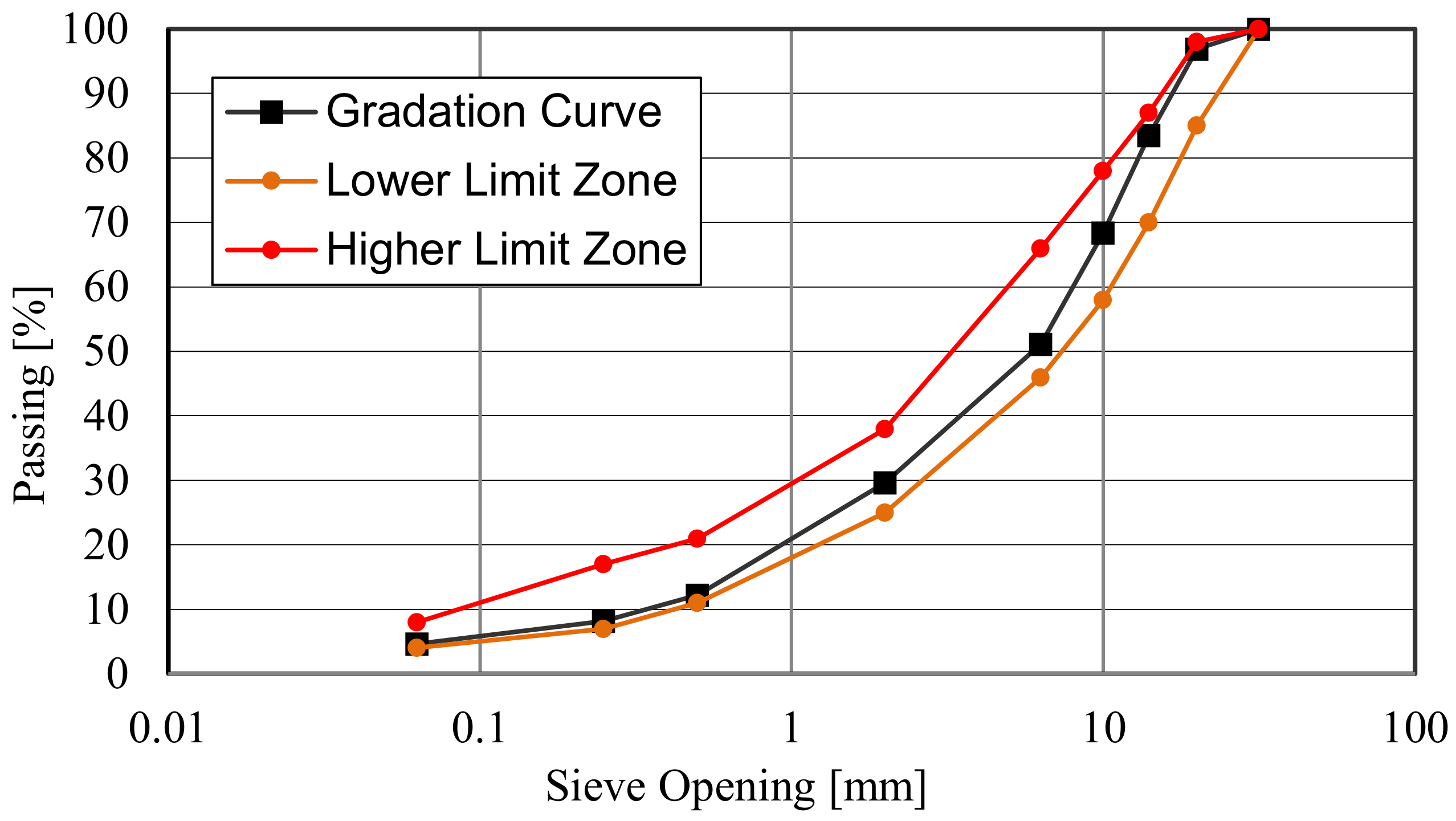
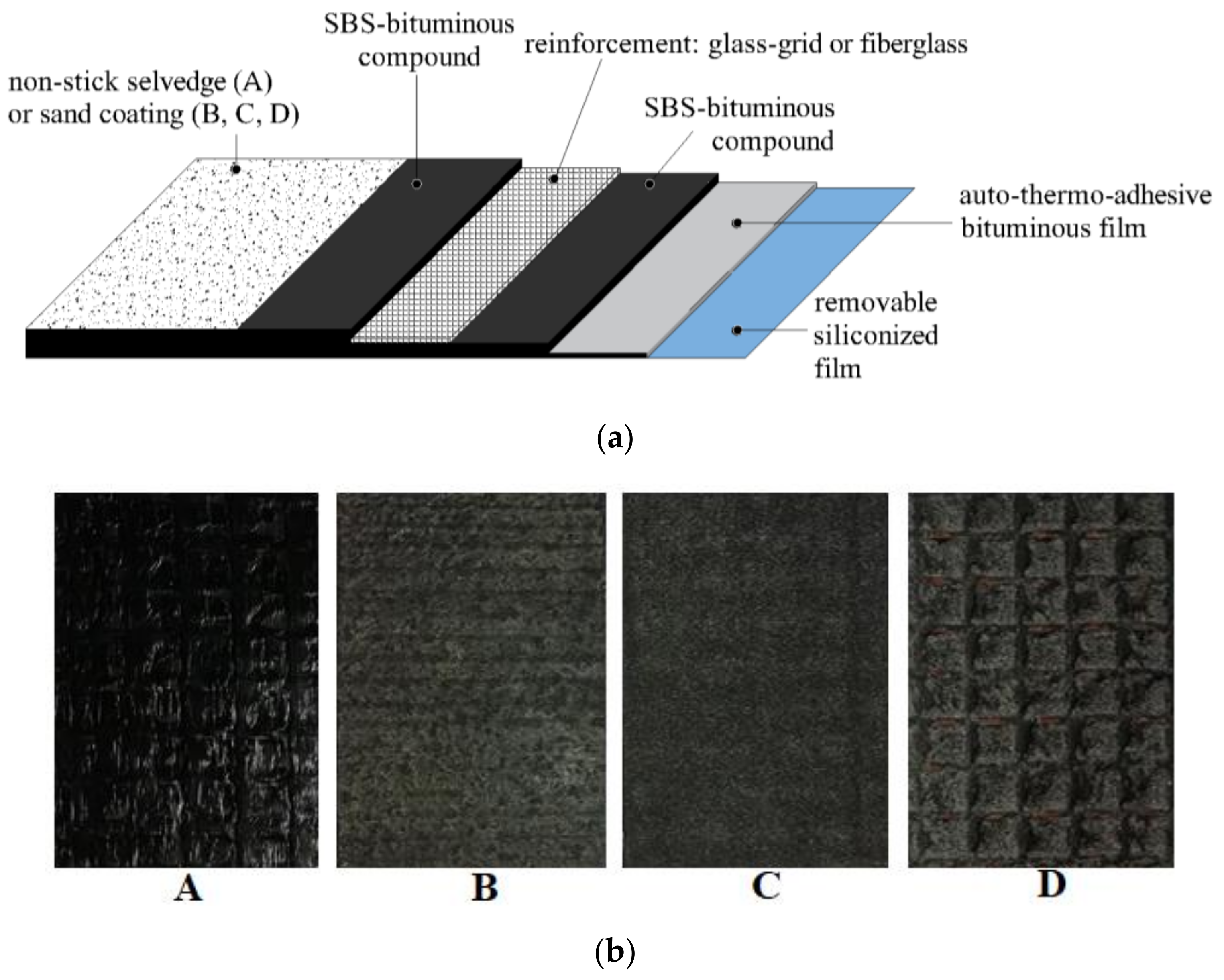
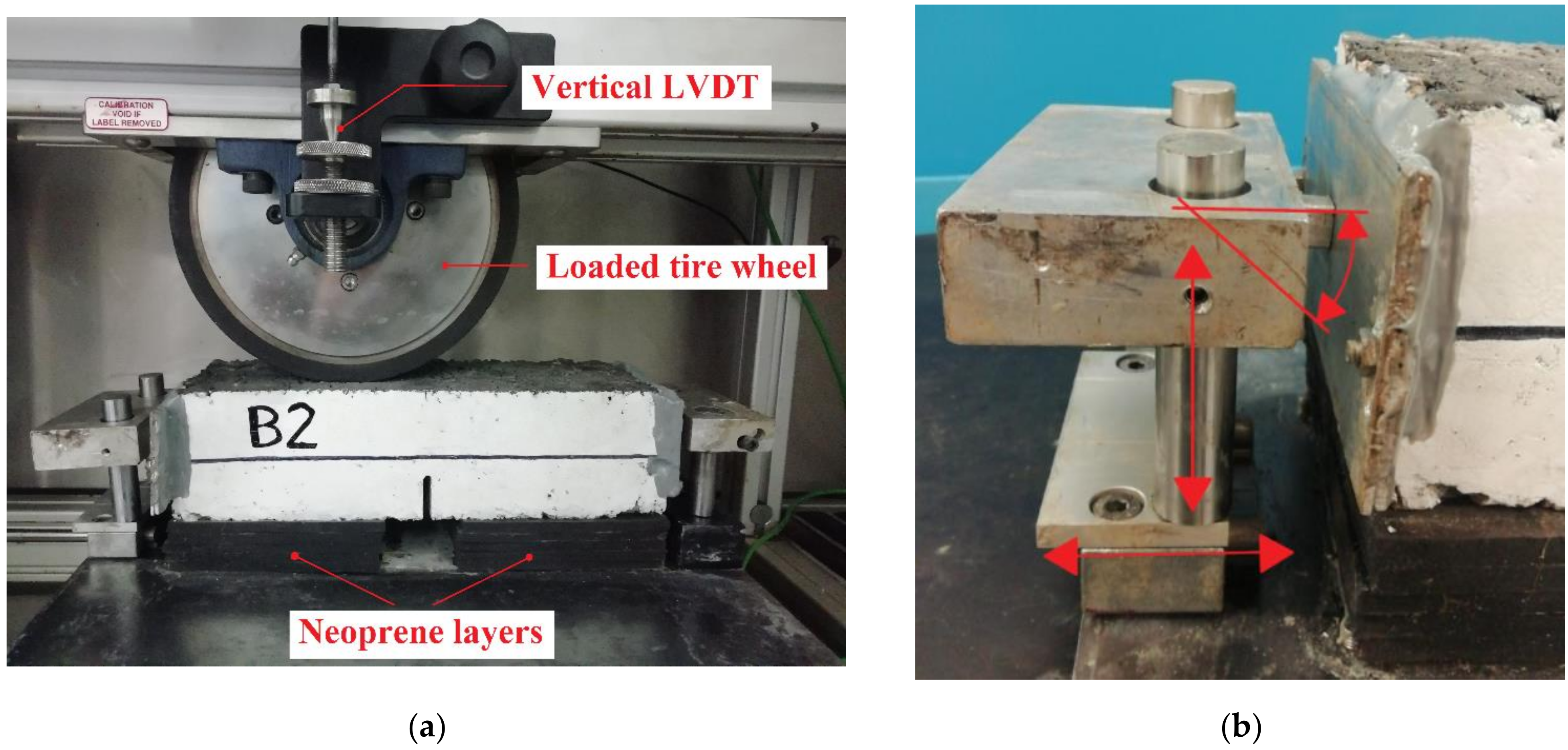

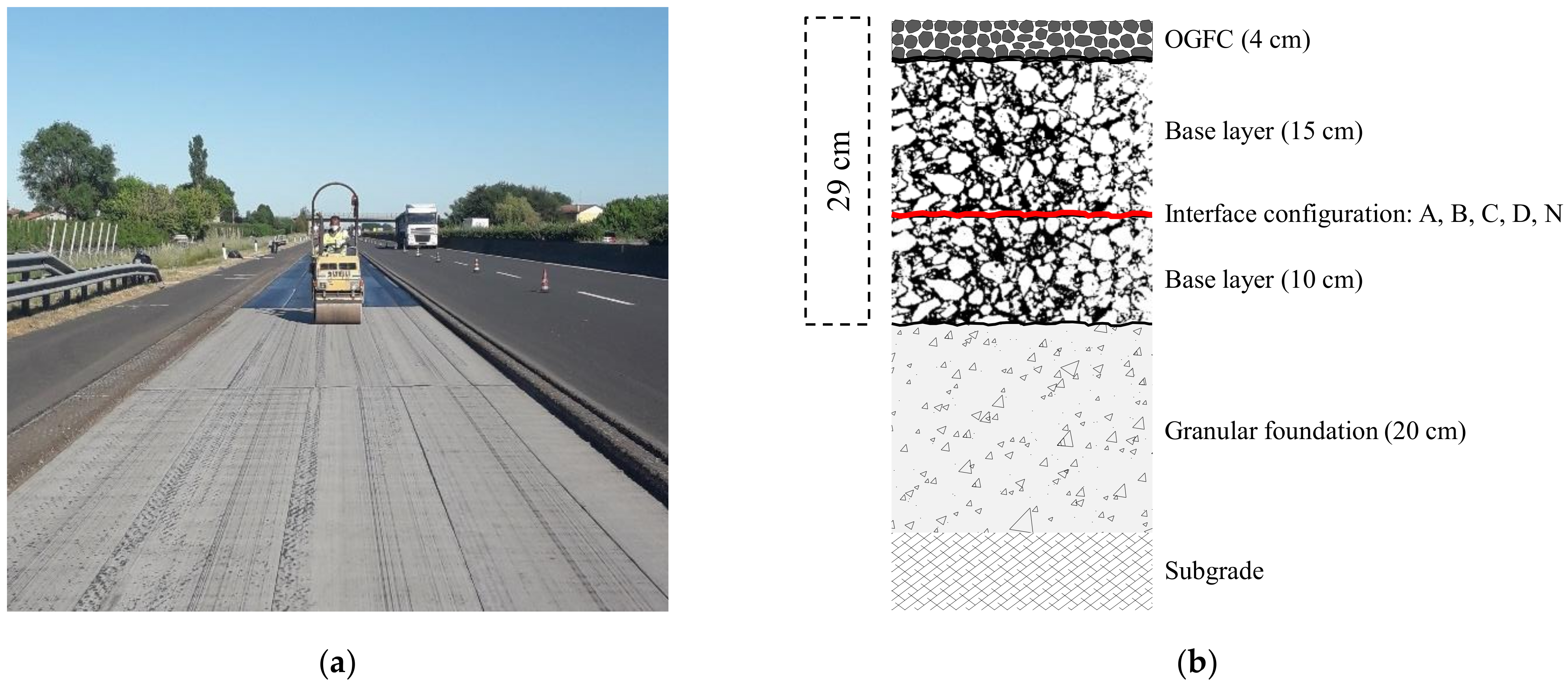
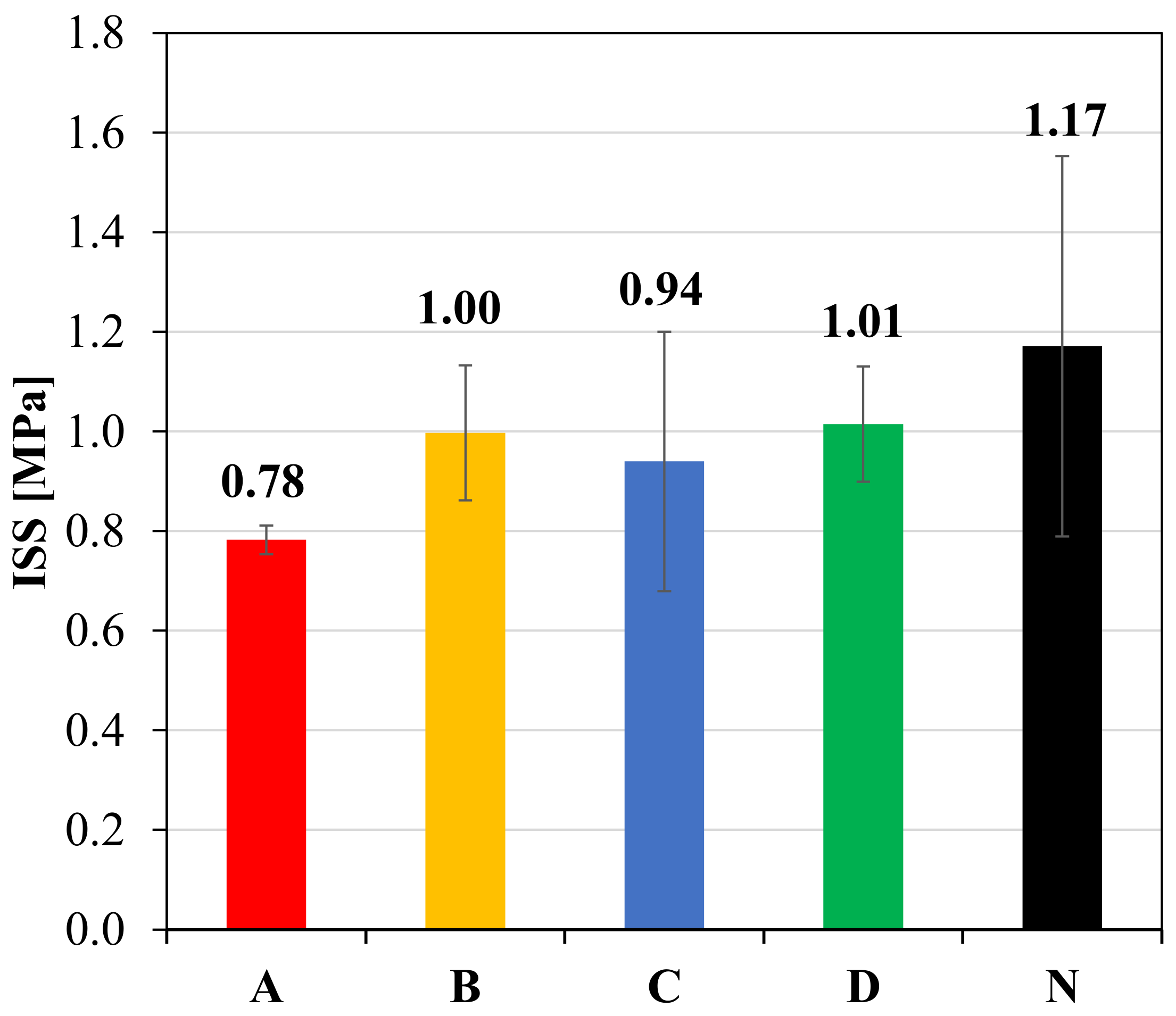
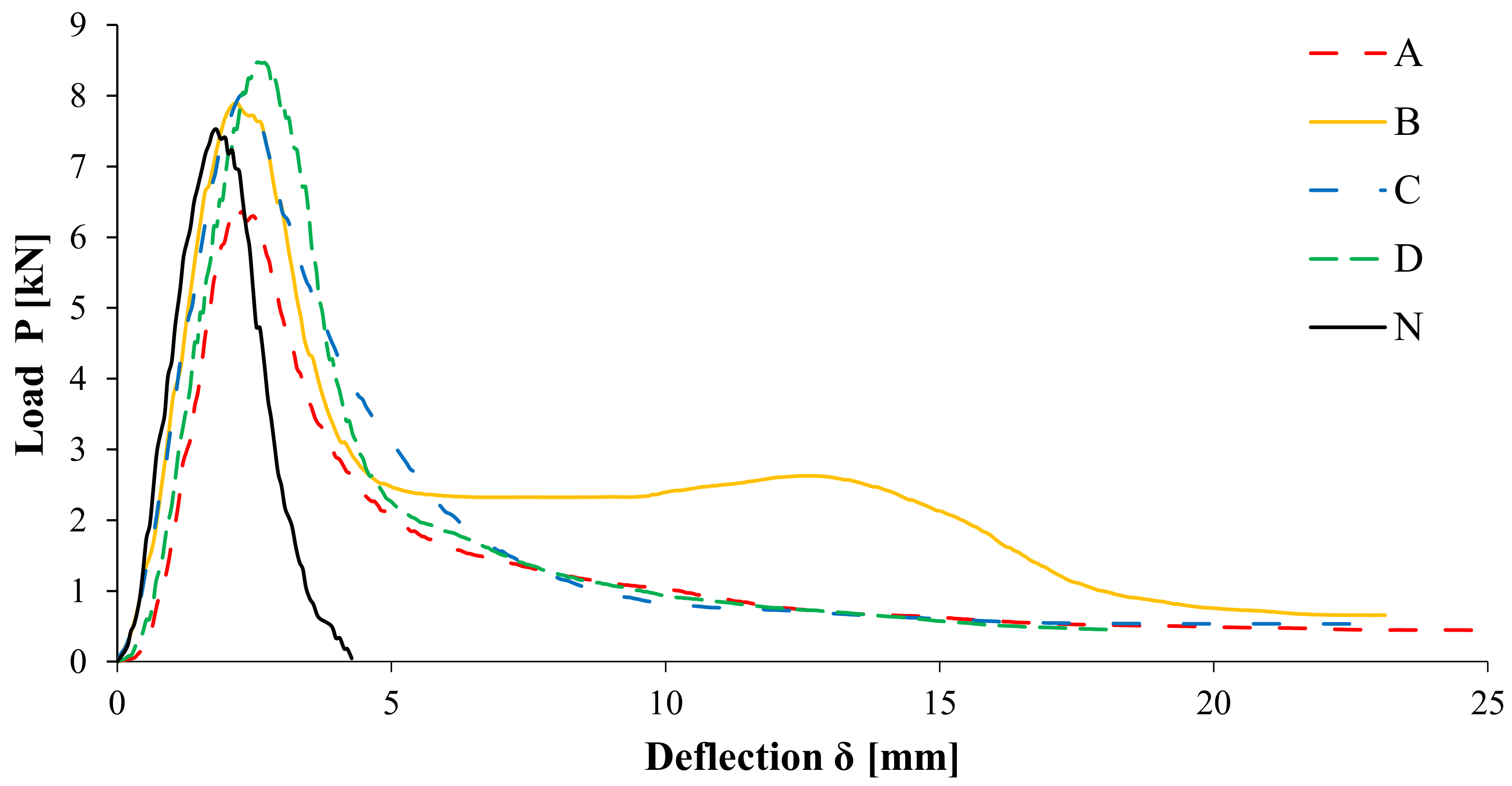
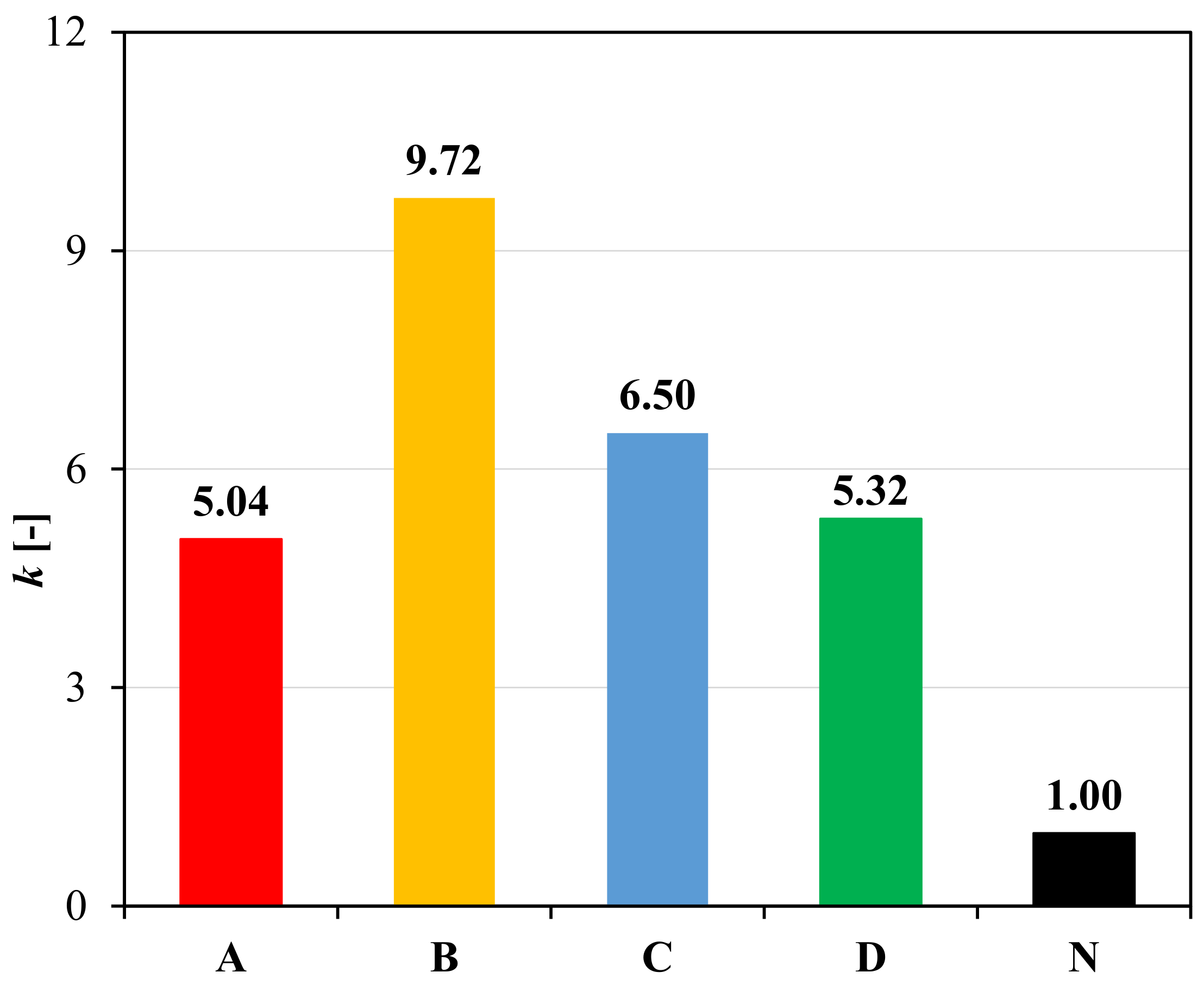
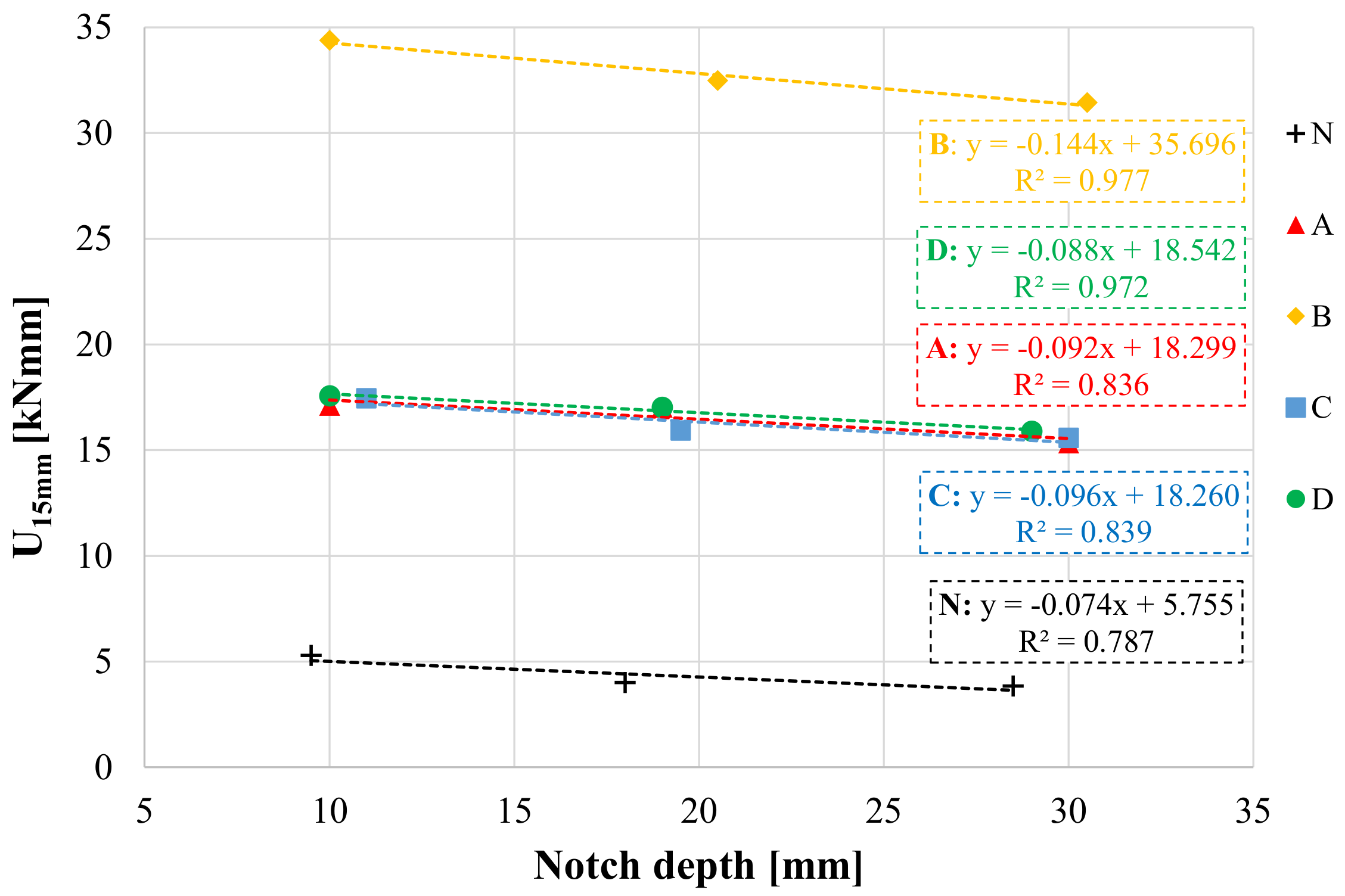
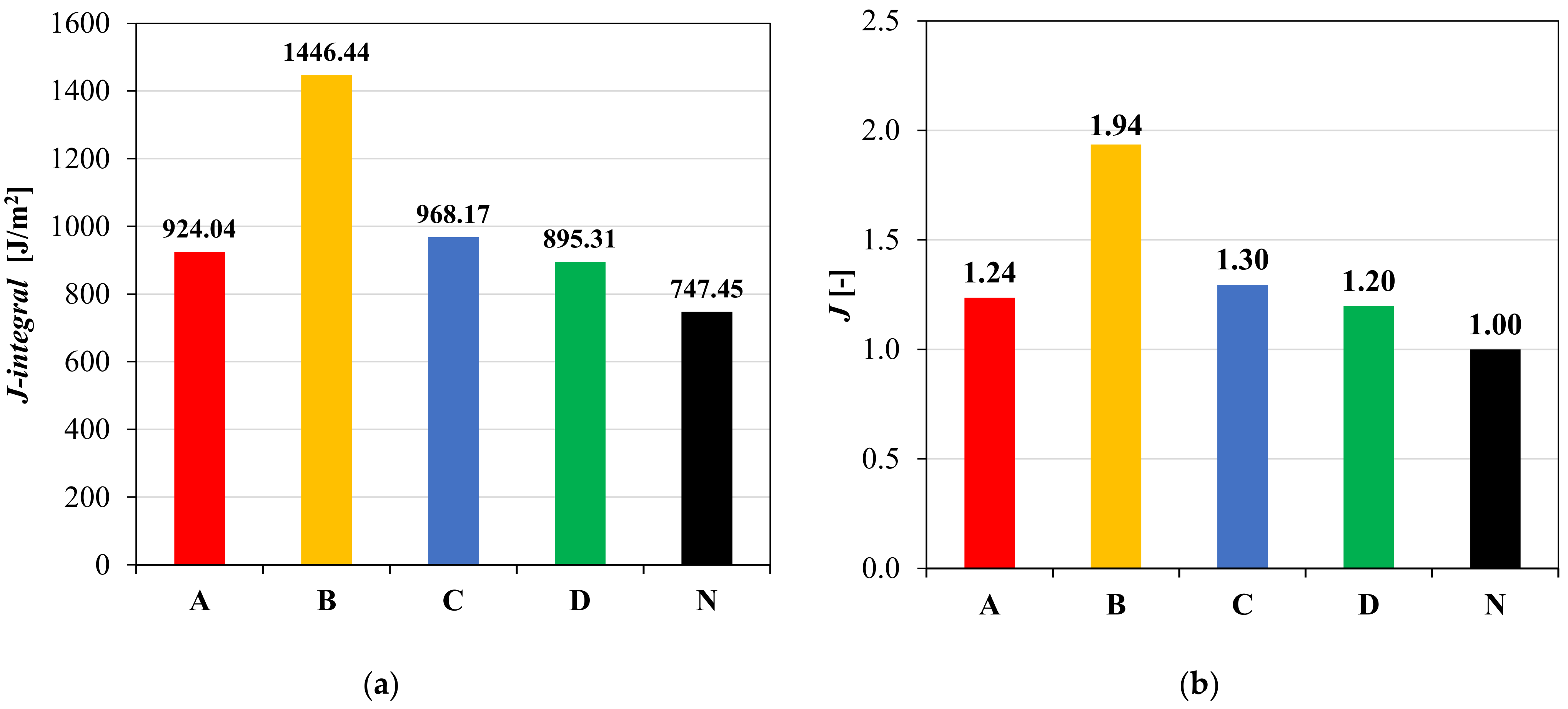
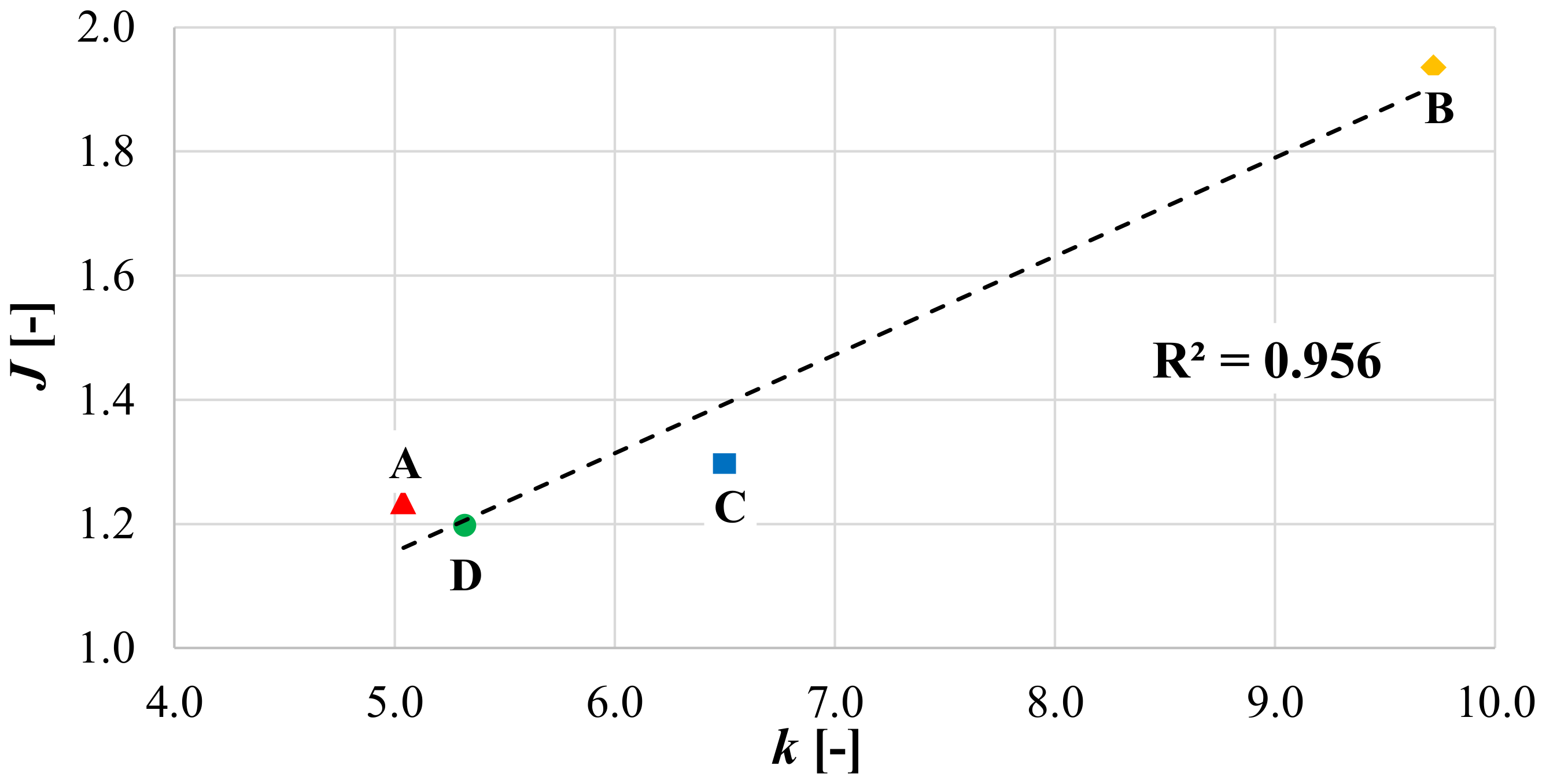

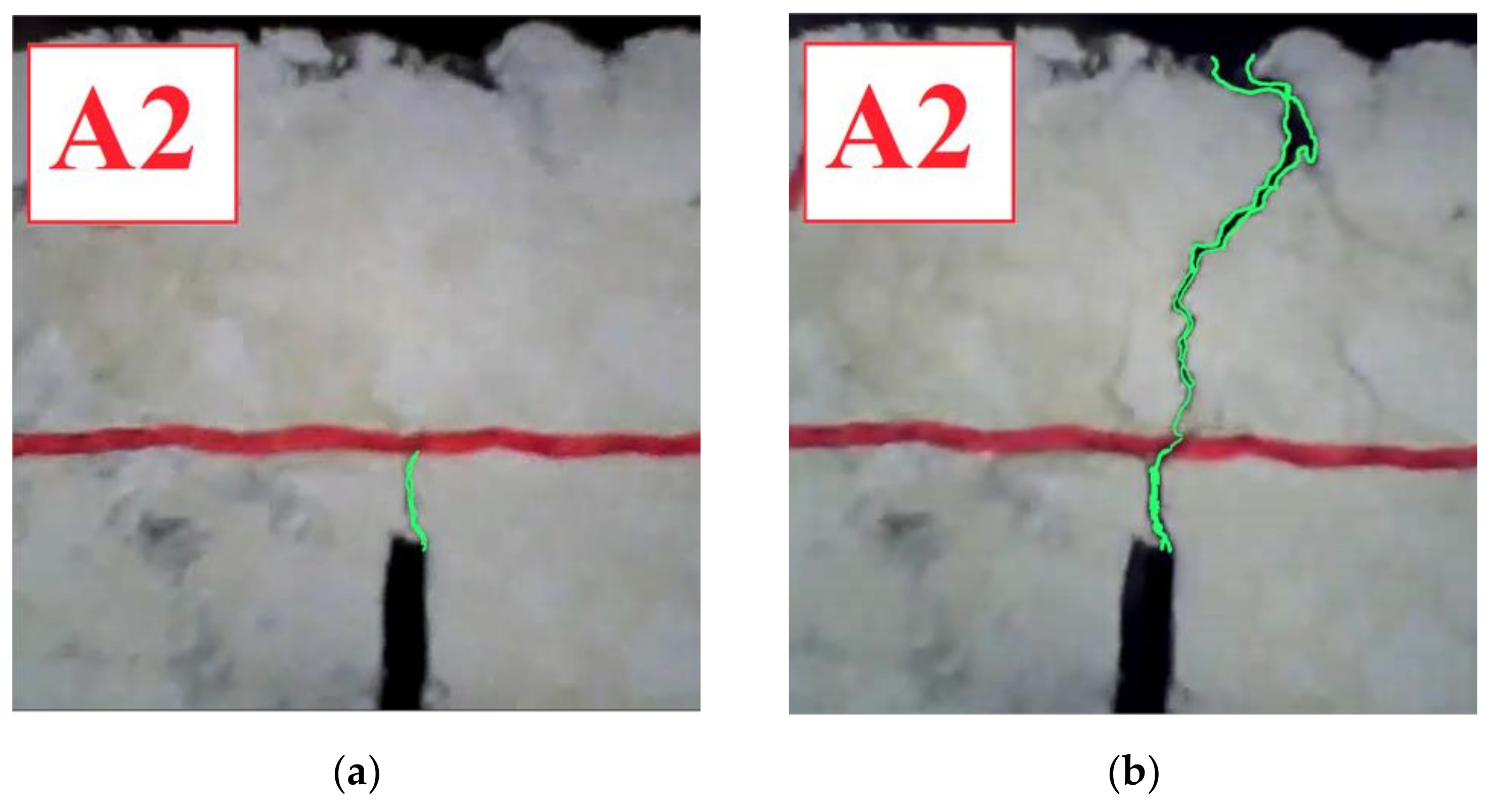
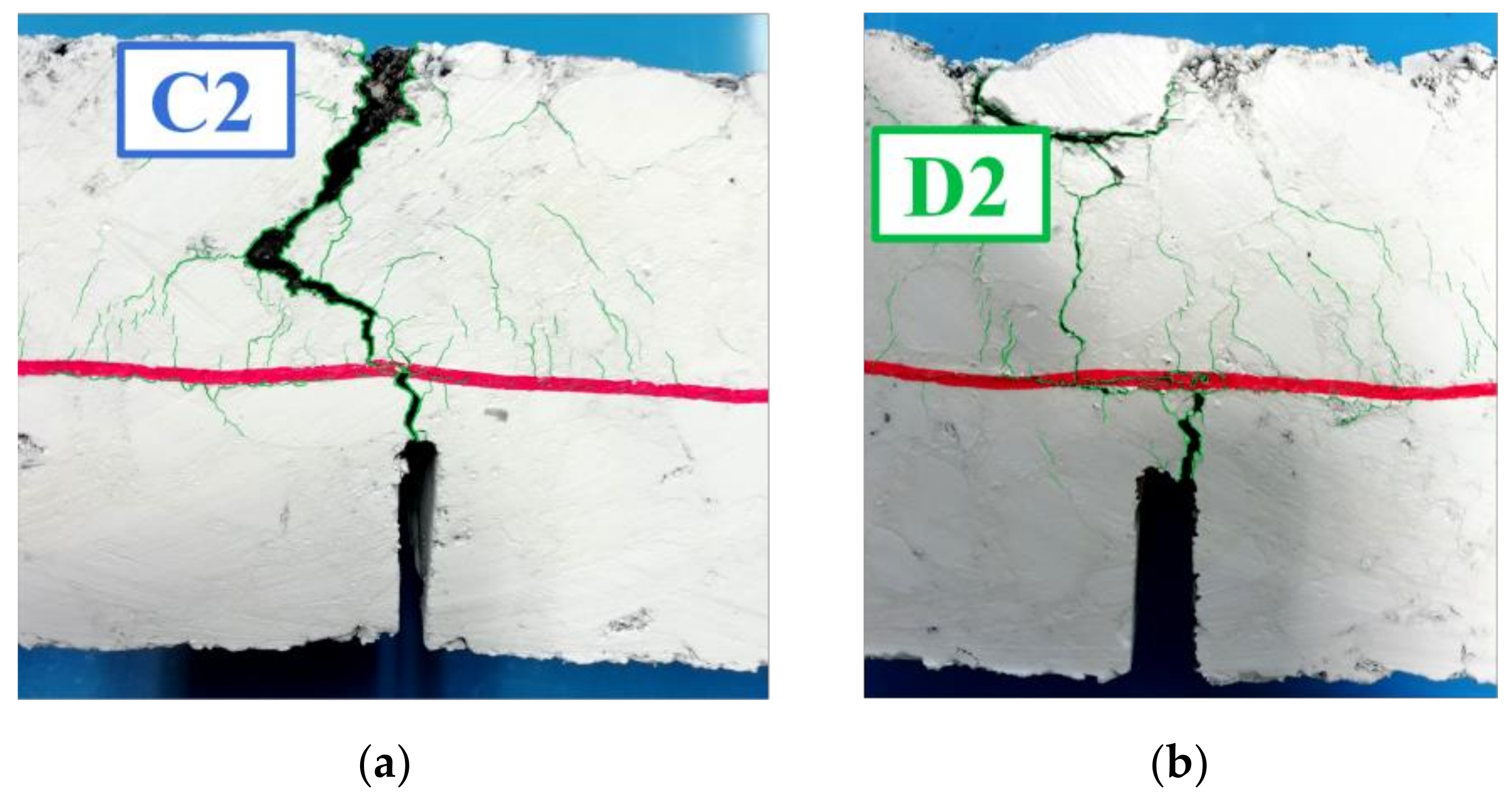
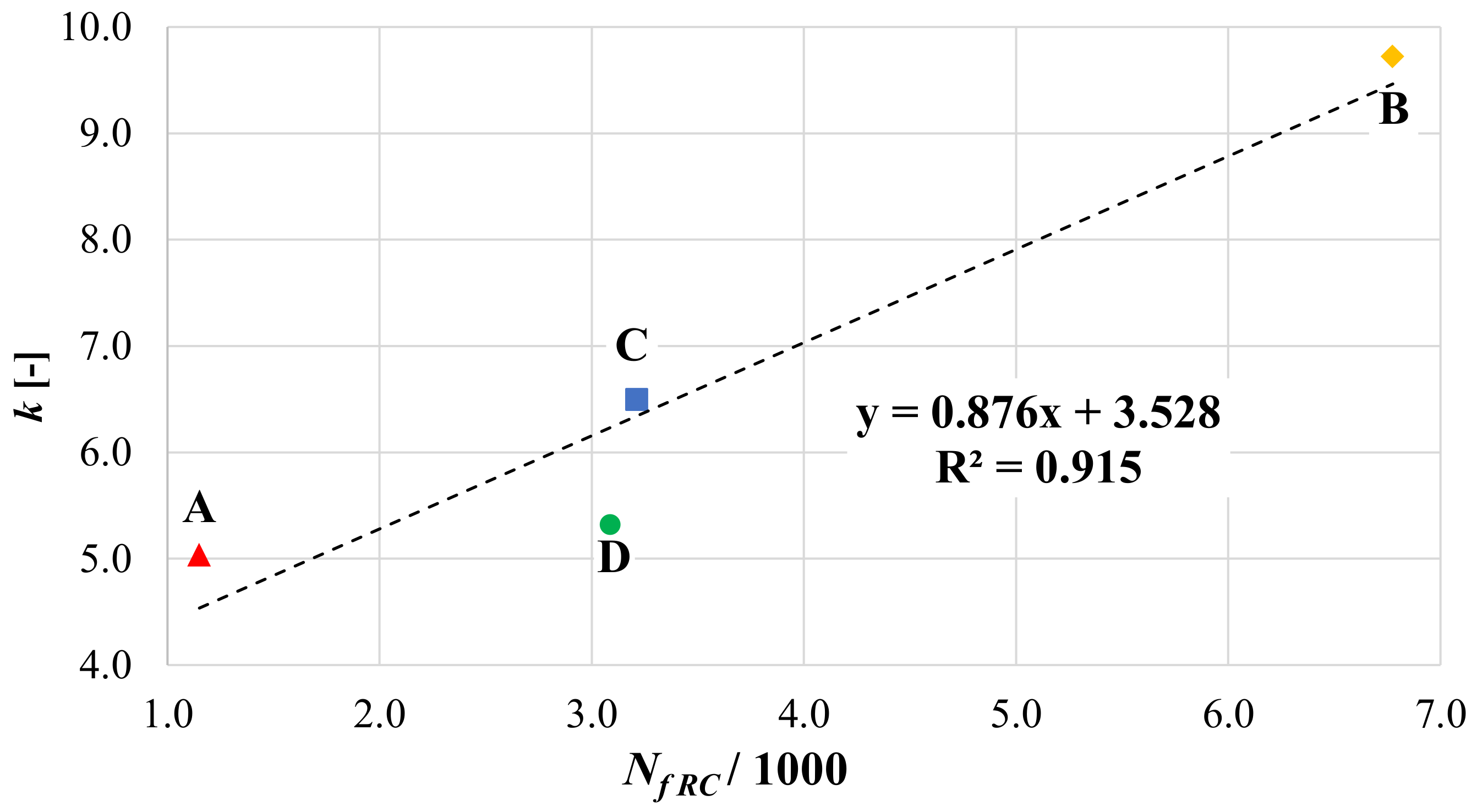
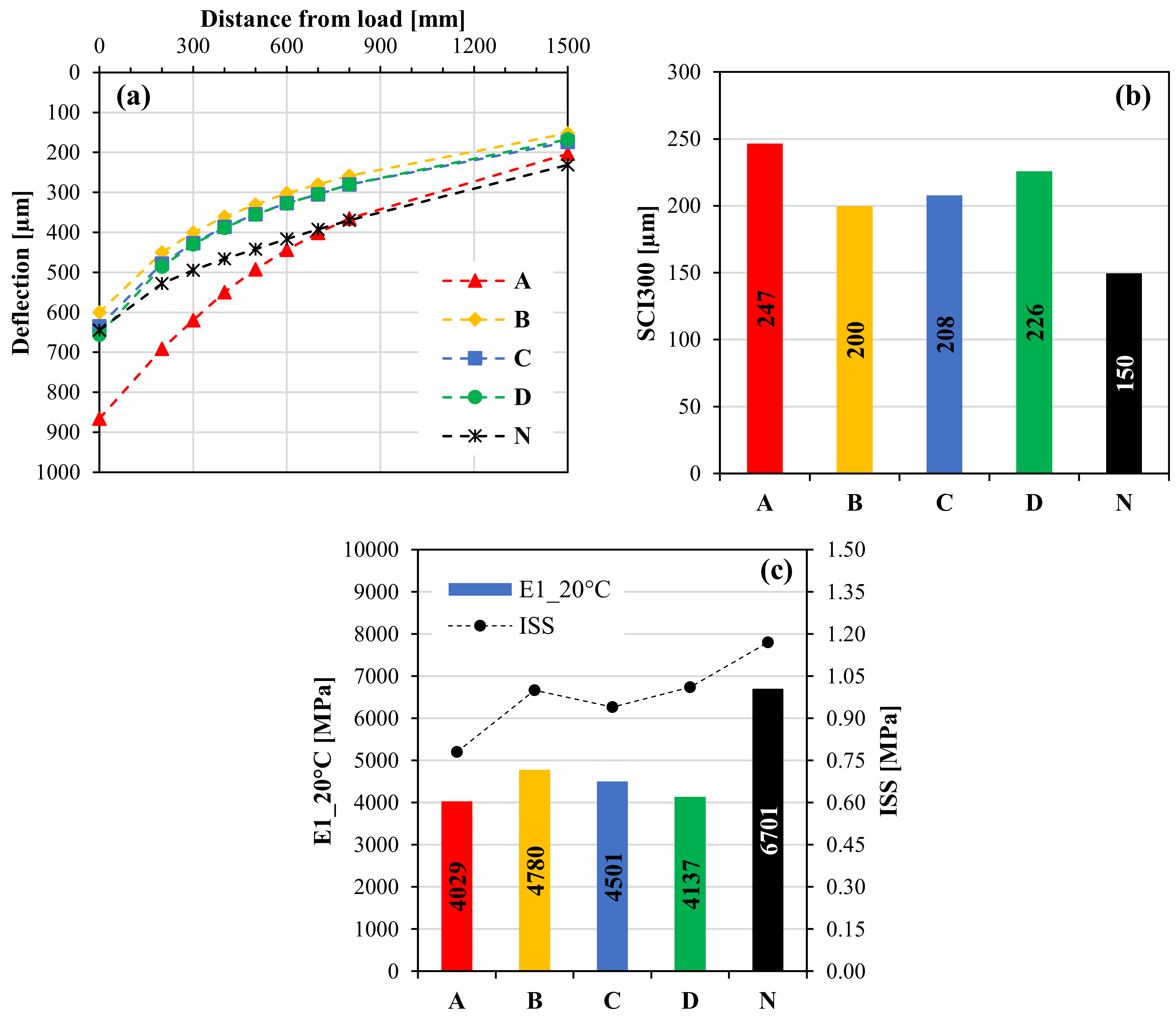
| A | B | C | D | |
|---|---|---|---|---|
| Nominal tensile strength L/T (kN/m) | 40/40 | 35/35 | 40/44 | 40/40 |
| Tensile elongation at failure L/T (%) | 4/4 | 30/30 | 3/3.5 | 4/4 |
| A | B | C | D | |
|---|---|---|---|---|
| Crack propagation rate (mm/1000 cycles) | 2.19 | 0.52 | 0.94 | 1.18 |
| Number of cycles to failure, Nf RC | 1150 | 6775 | 3213 | 3088 |
Publisher’s Note: MDPI stays neutral with regard to jurisdictional claims in published maps and institutional affiliations. |
© 2021 by the authors. Licensee MDPI, Basel, Switzerland. This article is an open access article distributed under the terms and conditions of the Creative Commons Attribution (CC BY) license (https://creativecommons.org/licenses/by/4.0/).
Share and Cite
Spadoni, S.; Ingrassia, L.P.; Paoloni, G.; Virgili, A.; Canestrari, F. Influence of Geocomposite Properties on the Crack Propagation and Interlayer Bonding of Asphalt Pavements. Materials 2021, 14, 5310. https://doi.org/10.3390/ma14185310
Spadoni S, Ingrassia LP, Paoloni G, Virgili A, Canestrari F. Influence of Geocomposite Properties on the Crack Propagation and Interlayer Bonding of Asphalt Pavements. Materials. 2021; 14(18):5310. https://doi.org/10.3390/ma14185310
Chicago/Turabian StyleSpadoni, Sara, Lorenzo Paolo Ingrassia, Giulio Paoloni, Amedeo Virgili, and Francesco Canestrari. 2021. "Influence of Geocomposite Properties on the Crack Propagation and Interlayer Bonding of Asphalt Pavements" Materials 14, no. 18: 5310. https://doi.org/10.3390/ma14185310
APA StyleSpadoni, S., Ingrassia, L. P., Paoloni, G., Virgili, A., & Canestrari, F. (2021). Influence of Geocomposite Properties on the Crack Propagation and Interlayer Bonding of Asphalt Pavements. Materials, 14(18), 5310. https://doi.org/10.3390/ma14185310








